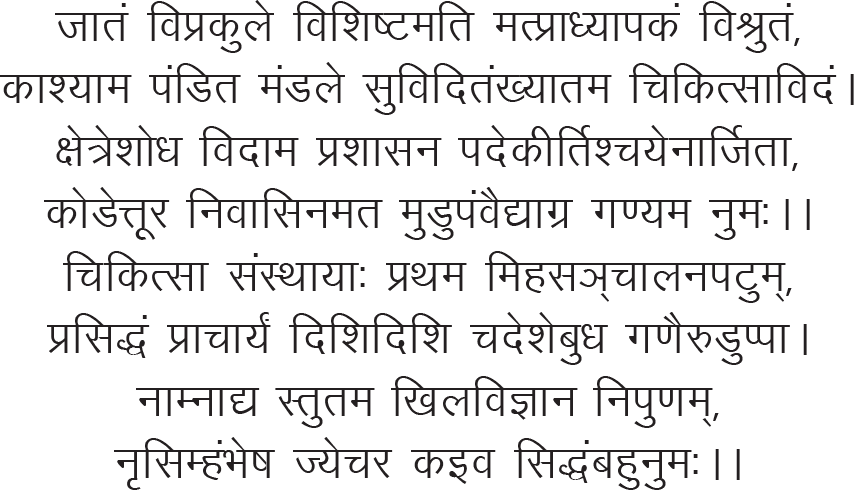
Export to PPT
Transliteration Jaatam viprakule vishistamati matpraadhyaapakam vishrutam, Kashyam Pandita mandale Suviditam Khyaatam chikitsaaavidam, Kshetreshodhavidaam Prashaasanapadekeertishaye naarjitaa, Kodetttoora nivaasinamta mudupamvaidyaagranumah. Chikitsaasamsthaayaah prathamamihasanchaalanapatum, Prasiddham Praachaaryamdishidishi cha deshebudhaganeih Uduppaa Namnaady stutma khilvijyana nipunam, Nrasihmam Bheishajye Charakaivasiddam bahu numah.
(Born in a priestly Sanskrit scholar family at Kodethoor Udupi, Narasimhan Udupa was an eminent professor of surgery, well known in the Varanasi scholar fraternity. Dr K. Narasimhan Udupa was the founder Director of the Institute of Medical Sciences and a skilful doctor like ancient Charaka.)
EARLY LIFE AND JOURNEY TO MEDICINEDr Kateel Narasimhan Udupa popularly known as Dr K.N. Udupa (Fig. 1) was born on 28 July 1920 in a priestly brahmin family at Kodethoor near Udupi in South Canara, Karnataka. His father Mr Thammayya was a Sanskrit scholar, expert in Vedic architecture and a practising astrologer. His mother Gangamma was a pious homemaker. Narasimhan was fourth of eight siblings. His father wanted him to follow the family tradition of learning Sanskrit and Vedas.1 By the time he cleared his class X level Sanskrit examination, he fell in love with medicine and expressed his desire to become a doctor much against the wishes of his father. He left for Madras (now Chennai), which had an Ayurvedic College and used to admit students who had passed class X. As young Udupa had essentially a Sanskrit-based traditional education, he was refused admission. Someone known to the family suggested that the Ayurvedic College at Banaras Hindu University (BHU) admits Sanskrit-medium class X students also; he decided to go to Banares on his own with an introductory letter for Professor Dasnacharya at BHU. Professor Dasnacharya helped him get admission into the Ayurvedic College awarding degree of AMS (Ayurvedacharya Medicine and Surgery) in 1936. This proved to be a turning point for him and there was no looking back. He cleared all professional examinations with distinction, standing first in the class. He passed his final AMS examinations in 1943. It is during this period he developed an interest in surgery, which was to become his future career.
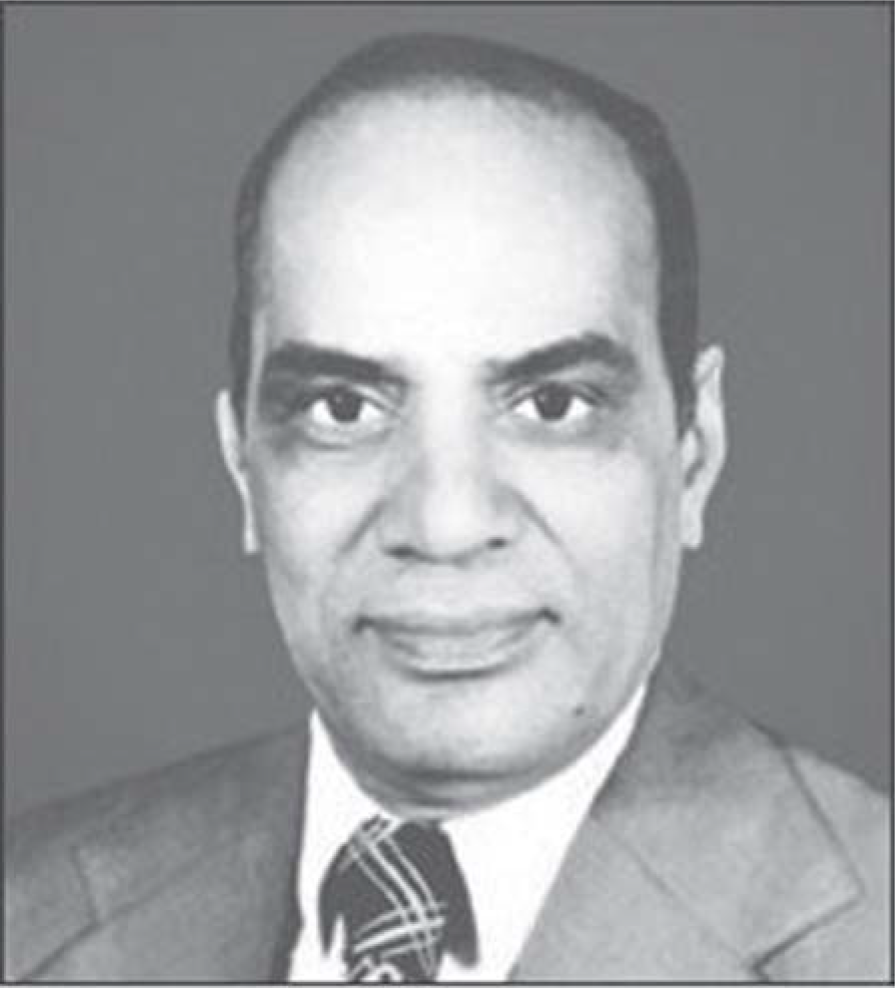
FIG 1.: Professor K.N. Udupa
Export to PPT
After obtaining his AMS degree, he went to Bombay Podar Ayurvedic College to Col. V.R. Mirajkar to learn surgical skills. After spending some time at Podar, he went to the USA for his Master’s in surgery at Michigan University, which he successfully completed in 1948. Soon after his MS he did his FRCS from Canada under the mentorship of Professor John Alexander at Michigan University. It was a rare feat for an Ayurvedic graduate to acquire a degree in modern medicine; this was being repeated after almost 110 years in India. In 1836 Vaidya Pandit Madhusudan Gupta, a Bengali Brahmin who was Vaidya by family tradition and a teacher in the old Sanskrit College which had been converted into modern medical school in 1835, known initially as Medical College Bengal, later as Calcutta Medical College achieved the same. Vaidya Madhusudan Gupta was appointed as Associate faculty to teach anatomy in the newly established medical school. Vaidya Gupta appeared formally in the final examination along with the second batch students to get qualified in modern medicine.2
After acquiring his MS and Fellowship of the Royal College in surgery, Dr Udupa returned to India in 1948 and joined the Central Health Services. He got his first posting at Mandi, Himachal Pradesh as a Civil Surgeon where he did all kinds of major surgery including complicated thyroid surgery. He soon became a household name. He was considered as an outstanding surgeon and treated like a demigod in that region. He again went to Harvard University School of Medicine, USA in 1954 and did work on wound healing with the world famous Dr J. Englebert Dunphy. His work on wound healing was published in reputed American journals including the New England Journal of Medicine. He came back to India and was posted at Shimla in 1956.3 Around this time there was student turmoil in the Ayurvedic College BHU. Students were demanding that Dr K.N. Udupa be brought there as principal of the College. Such was the pressure of the students that the then Prime Minister Pandit Jawahar Lal Nehru himself had to intervene and send Dr Udupa to BHU as Principal and Professor of Surgery at the Ayurvedic College, BHU in 1959. He joined the college and suggested to the university that it should have a Medical College in place of the Ayurvedic College to solve the perpetual problem of student unrest to which the university agreed after deliberations at the university, University Grants Commission and the Ministry of Education.2,3 Banaras thus became his ultimate ‘Karmbhoomi’ for another three decades, from 1960 till his last in July 1992.4
INSTITUTION BUILDERIt is worth mentioning that Professor K.N. Udupa was the alumnus of the former Ayurvedic College. Soon after joining the Ayurvedic College as principal, he persuaded the university to start MBBS courses (Fig. 2). Thus was born the College of Medical Sciences in 1960, which was declared as the Institute of Medical Sciences in 1971. By the time he was to hand over the reins to Professor J. Nagchaudhauri the next Director incumbent in December 1980, he had laid a sound infrastructure for 10 major super specialties of medicine including Cardiology, Neurology, Nephrology, Endocrinology, Gastroenterology, Cardiothoracic Surgery, Neurosurgery, Urology and Plastic Surgery. All these courses had started leading to DM and MCh degrees in the respective disciplines. This amply reflected his dexterity, steadfastness, devotion, versatility and dedication towards the institution. He was a true visionary.5
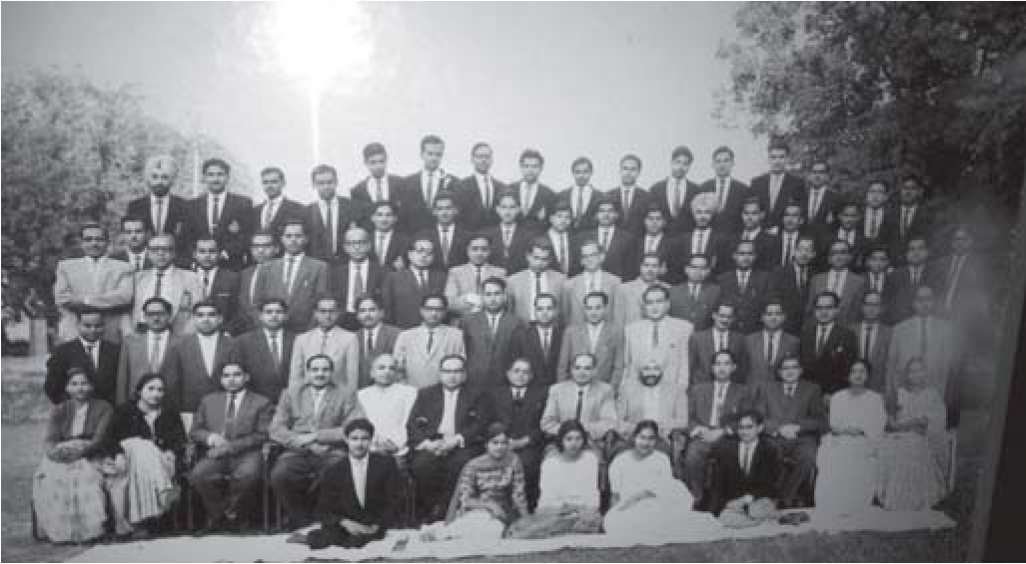
FIG 2.: First batch of MBBS students with Professor Udupa and the faculty
Export to PPT
He could take the institution to such dizzy heights in a short span of 10 years because of his stellar qualities of head and heart, intimate rapport with his students and university administration and close liaison with the University Grants Commission particularly its secretary Mr Chabra and Central Health Ministers like Dr (Miss) Sushila Nayyar, Dr Karan Singh and Mr Raj Narain. He enjoyed full confidence of all Vice Chancellors since the day of his joining the university till his superannuation in 1980; be it Dr V.S. Jha (1956–60), Justice N.H. Bhagwati (1960–66), Dr Triguna Sen (1966–67), Dr A.C. Joshi (1967–69), Dr K.L. Shrimali (1969–77), Dr M.L. Dhar (February– December 1977), or Dr Hari Narain (1978–81). This was the time when IMS BHU had several legends notably Drs H.S. Bajpai (Medicine/Internal Medicine), M.K. Basu Mullick (Obstetrics and Gynaecology), P.K. Das (Pharmacology), P.J. Deshpande (Shalya-Shalakya), B. Dube (Pathology), D.S. Gaur (Basic Principles), N.N. Khanna (Surgery), K.S. Mehra (Ophthalmology), K. Pandey (Anaesthesiology), P.V. Sharma (Dravya Guna), A.D. Singh (Radiotherapy), Shamer Singh (Anatomy), P.N.Somani (Cardiology), S.M. Tuli (Orthopaedics), Y.N. Upadhyay (Kaya Chikitsa), M.P. Vaidya (Surgery), etc. While they were eminent personalities in their own right, it was Professor Udupa who galvanized and unified them in one strong thread for the overall growth of the institute.
His infectious smile and charisma were well known. Though he retired in 1980, the glow of harnessing such a mammoth institution could be seen on his face in an All-India Forensic Conference when he was sharing the dais with Kashi Naresh Dr Vibhuti Narain Singh even in 1991. Almost wedded to his mission of making this institution of Mahamana Madan Mohan Malaviya as a model for the entire country, he used to work day and night and would be in hospital, college or the surgical research laboratory, a place where he enjoyed maximum relaxation and/or the college library. Such was his thirst for research and to remain updated not only in his subjects only but also in the sister disciplines. Even in Delhi when he used to go for any official purpose, he would always visit the National Medical Library (NML) and consult the journals of his choice. This was revealed by Dr (Miss) Chitle, the Chief Librarian of NML during her visit to IMS in the 1980s.4,5
TRUE KARMYOGIHe was an outstanding surgeon, clinician, and karmyogi in the true sense. His daily schedule started at 8:30 a.m. and continued till 9 p.m. with hardly a gap for lunch and an evening snack in office itself. After superannuation in 1980, he got busy with the Indian Council of Medical Research (ICMR) Research Project on Rural Development. He was always available for community service and healthcare and was considerate in treating poor and economically backward patients.
MENTOR PAR EXCELENCEOne of the unique qualities which Dr Udupa possessed was to mentor his students and colleagues, enriching their skills and knowledge continuously. Just to cite some examples: It was upon his goading that Dr A.P. Pandey moved to Christian Medical College, Vellore for doing his MCh Urology under the legendary Dr H.S. Bhat. Dr A.P. Pandey later received the Padma Shri for his pioneering work on renal transplant. Dr V.K. Shukla, the current Vice Chancellor who followed in his footsteps in Surgery. Dr K.D. Tripathi of the first batch was a name to reckon with in pharmacology. It was during one of his evening walks after ward rounds that I got a hint to do my PhD work on ‘Prostaglandins in ischaemic heart disease and the beneficial role of Terminalia arjuna in ischaemic heart disease’.6,7 There are umpteen number of such important leads given to students by Dr Udupa. Professsor Nayna Udupa, currently Research Director at MDM University, Dharwad is also one of them. There are many such shining stars spread all over the country and abroad.8
Even to a senior colleague like Professor S.M. Tuli, Professor of Orthopaedics, he suggested to examine the beneficial effect of a plant popularly known as ‘Hadjod’ (Cissus quandrangularis) in the healing of bones. Sure enough, Dr Tuli carried out experiments on the fluid collected from this plant and demonstrated the presence of anabolic hormones in it. Professor Tuli also wrote an article ‘Five thousand years of orthopaedics in India’, which was published in Clin Orthop. Such was the persuasive power of Professor Udupa on the faculty and students.9,10
DEDICATED RESEARCHEROne of his lesser known contributions was the establishment of the Surgical Research Laboratory in the early 1960s. This laboratory became a focus of research activities for many young researchers including non-medical scientists leading to the award of a PhD degree. He used to visit the laboratory regularly every evening and review the progress made by each staff. This was the place where he performed his famous studies on the effect of yoga on neuro-humors.
TRUE DISCIPLE OF SUSHRUTADr Udupa was a true disciple of Sushruta, the great ancient surgeon of India. Dr Udupa was the first in the country to have installed a statue of Sushruta in S.S. Hospital (Fig. 3).12 He started the Quarterly Journal of Surgery with Sushruta on its cover page reflecting his seminal contribution. He worked tirelessly to get recognition for ‘Sushruta’ as the ‘Father of Surgery’ by the western academia. The statue installed in the S.S. Hospital old building ground floor surgery block is a living example of the vision and affection to ancient tradition.11 True to Sushruta’s teaching he believed in his aphorism:
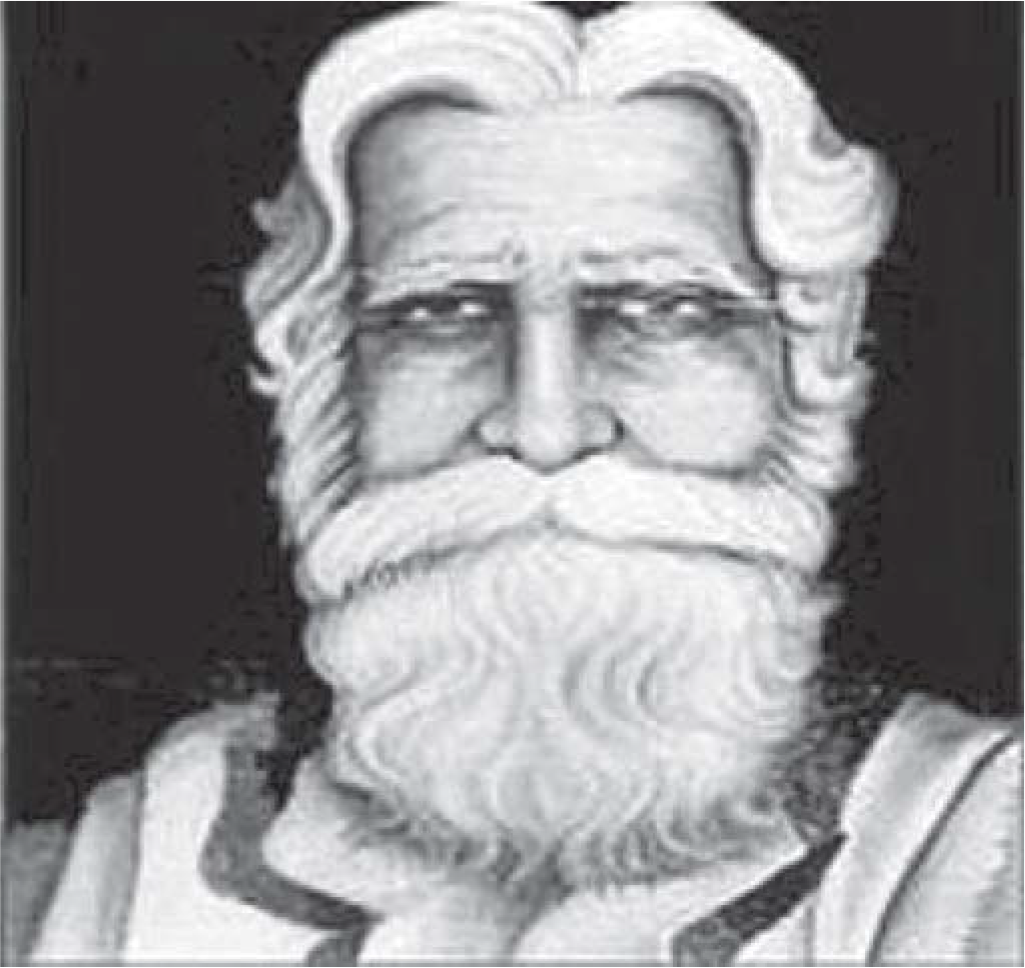
FIG 3.: Bust of Sushruta in Sir Sunderlal Hospital, Banaras Hindu University
Export to PPT

Export to PPT
Keep on updating yourself continuously—a concept in consonance with the present-day continuing medical education programmes and updates.
STAUNCH SUPPORTER OF MODERNIZING AYURVEDAHe always encouraged and used traditional knowledge of medicine, yoga and ayurveda. He wrote several scientific monographs. Prominent among them was on ‘Stress and its management by yoga.’12 He was a strong votary of integrated medicine. He tried to develop this model at BHU by having a faculty of Modern Medicine and Indian Medicine under one roof—the IMS. This unique model is running successfully.
UNWAVERING CONFIDENCE IN HIS STUDENTSI would like to recall two distinct episodes of my time. I was working as Medical Officer in-charge of the Student’s ward of S.S. Hospital. His nephew, Mr Nayna Udupa, was admitted with high fever under my care. His fever was not coming down and next day was his final examination at the Institute of Technology, BHU. He was very worried but had full faith in me. He asked me if something else could be done? I immediately sought advice from Professor Bajpai, the head of Medicine at that time. Fortunately, Nayna’s fever started coming down the next day morning.
The second episode pertains to a senior professor at the Institute of Technology, BHU. The professor came to my chamber one morning as he had extreme weakness. He was accompanied by a senior official of the hospital. I found him to be extremely pale due to bleeding piles and issued a medical certificate about this in good faith as requested by my hospital colleague. I did not know that the professor had incurred the wrath of the then Vice Chancellor and was to appear before the Disciplinary Committee. Taking help of my medical certificate he did not appear before the committee. The Vice Chancellor was very annoyed with the medical certificate. He called Professor Udupa to investigate the veracity of the illness. Dr Udupa told him that if Dr Dwivedi has issued this certificate it must be true and genuine.
HELPING THE HONEST, HUMBLE AND SCRUPULOUSDr Udupa had a very sharp memory. He would call every student by his name and place. He never compromised work with self. Not to be forgotten in this regard are stalwarts like Professor P.N. Somani and Professor S.M. Tuli. Professor Tuli has done seminal work on skeletal tuberculosis. He is still remembered and cherished by his endless number of patients streaming to Delhi even after so many years.
I enjoyed Professor Udupa’s blessings in plenty right from my joining as an undergraduate in 1963 till his last in July 1992. I must confess that after completing my PhD under him in 1986, I expressed a desire to move to a totally academic position. He helped me in getting a teaching position at Kasturba Medical College, Manipal, Karnataka. Thereafter, destiny took me to University College of Medical Sciences (UCMS), New Delhi. He was immensely happy when I became Professor at UCMS in 1991 and wrote an affectionate congratulatory note full of advice and blessings to me. It was again providence that when he was critically ill after major abdominal surgery in July 1992, destiny took me to Allahabad, Uttar Pradesh Public Service Commission where I was informed by Professor A. Verma that he was ill and hospitalized. I took a train and reached Varanasi the next morning only to find him in the coronary care unit of the university hospital. He gave his characteristic smile. It was a tearful evening. Here was a person whose surgical hands and magic scalpel gave life to thousands of sick people and now he was under the knife and we all were praying for his life. Sadly he could not be saved, and he succumbed soon. Thus came an end to an illustrious son of Mother India who toiled day and night educating and training the young mind in the art and science of medicine.13
IMS BHU IN HIS TIMEHis was the time when IMS witnessed visits by Prime Minister Lal Bahadur Shastri in 1964 to inaugurate the Eye and ENT Hospital; Mrs Indira Gandhi, the Minister for Information and Broadcasting for opening the Children’s Hospital in 1965; spiritual leader Mata Anandmayee and several eminent personalities belonging to medical fields. Bharat Ratna Shehnai maestro Ustad Bismillah was a very familiar name at the cultural nights. Mother Teresa another Bharat Ratna visited the IMS Hospital on 13 March 1980 (Fig. 4).14
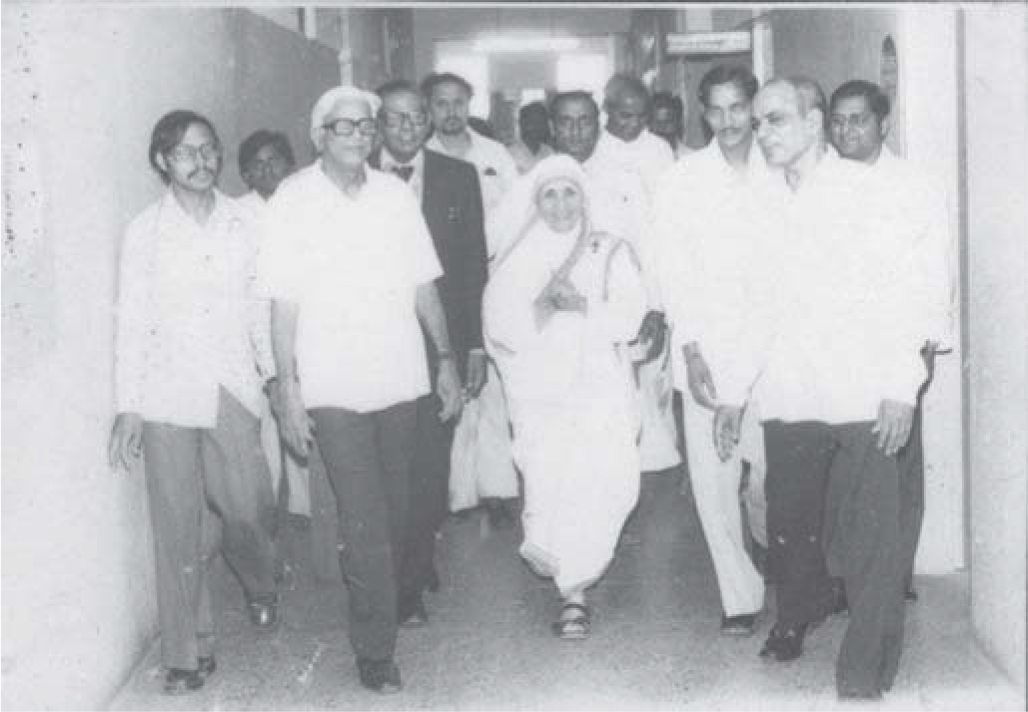
FIG 4.: Dr Udupa briefing Mother Teresa during her visit to the Institute of Medical Sciences, Banaras Hindu University
Export to PPT
CONCLUDING REMARKSProfessor Udupa came from the classical Sanskrit stream and Ayurveda, but he rose to dizzy heights of modern medicine solely due to his firm determination and dedication. IMS BHU is a living testimony of Professor Udupa’s perseverance, vision and honesty towards healing science and research. He still rules heart, mind and soul of his countless disciples spread all over the world.
Let us take forward his work ethics, values and aspirations further not only at IMS BHU but at other places too wherever we are.
That physical light persona no more,
Spiritual soul KNU in us sparks for ever.
A real Colossus he was.
留言 (0)